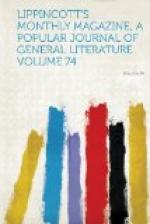One eminently satisfactory feature of the panic in securities was, that it did not extend to United States bonds, greenbacks or National bank-notes. Bonds were of course depressed in sympathy with the scarcity of money and the demoralization prevailing in the general stock market, but there was not the slightest loss of confidence in them among holders, nor any pressure to sell, except to relieve urgent necessities among the banks and others having need of currency. The paper money of the country proved itself the most valuable kind of property that any one could possess; whereas under like circumstances, in former times, when banks under the State laws could practically issue as many notes as they chose, much of it would have been left worthless and the remainder depreciated. But our currency system is defective in one essential particular: it is not elastic. It is, so to speak, hide-bound at seven hundred and ten millions of paper, exclusive of fractional currency, three hundred and fifty-six millions of which are legal-tender notes, and three hundred and fifty-four millions National bank-notes. The safety-valve of a country’s circulating medium is its elasticity, and the sooner Congress authorizes free National banking on the present basis of ninety per cent. of currency to the par of United States bonds deposited with the Treasury, or devises some other means of affording relief, the better for the interests of the nation. The law requiring the banks in the large cities to keep always on hand




